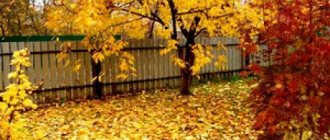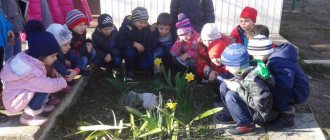Kindergarten lesson notes. Insect life in autumn
Content
Kindergarten lesson notes. Insect life in autumn
Summary of lessons in kindergarten. The world. Middle group.
Topic: “The life of insects in autumn.”
Objectives: To promote the formation of basic concepts about insects. Develop ideas about the adaptation of insects to ongoing changes in nature. Teach children to be careful and take care of insects. Develop an interest in living nature, the ability to see the beauty of nature.
Teaching methods: Playful, demonstration, explanation, questions, reminder, individual approach, assessment.
Preliminary work: Observation. Looking for some insects in the kindergarten area (summer, early autumn).
Individual work: Learn to answer the teacher’s question with a sentence.
Materials and equipment: Insects (rubber toys). Autumn leaves (made of paper), pebbles, stump. Paintings depicting insects (dragonfly, grasshopper, bee, beetle, mosquito).
Progress of the lesson:
The teacher draws the children's attention to the cockerel sitting on the window.
Educator: Children, it seems to me that the cockerel is upset about something, let's ask why he is so sad.
Petushok: I'm very sad because I can't find my friends. In the summer I had a lot of them, but then they all disappeared somewhere.
Question: Who are your friends? Petushok: Now I’ll tell you riddles about them, and you try to guess:
1. From a flower to a blade of grass, From a bush to a path. A spring jumps - a green back.
2. Flies over the meadow, dances, waves a beautiful fan.
3. The busy housewife circles over the colorful lawn. Work on the flower. He will treat her with honey.
4. The airplane is not made of steel. The nose is made with a thin needle. – He flies and squeaks, tries to bite everyone (Mosquito)
Question: Mosquito, bee, butterfly. How can we call them in one word? (Insects).
Petushok: You guessed all my friends correctly, all that remains is to answer the question of where they all disappeared to.
V o p i t a t e l: Children, let's help the cockerel. Now we will go in search of the missing insects.
(Children are invited to look for hidden insects. They find them under leaves, behind bark, under pebbles).
Vopitatel: Guys, where did the insects disappear to? (Insects hid under the bark of trees, in stumps, under stones).
Vopi tatel: That’s right, children, this is how insects survive winter. Because in winter it is cold and there is no lush grass and flowers. And in the spring, when the sun warms up and grass and flowers begin to grow, they will come out of their hiding places and will again delight us with their beauty and cheerful buzzing. (Photos of insects are displayed on the easel). 2-3 children are called, they are asked to show and name the body parts of insects.
Next, children are given cards with images of butterflies, beetles, and dragonflies and are asked to color them.
Vopi t atel: Well done, guys, what beautiful insects you have turned out to be.
Let's give our drawings to the cockerel so that he won't be so sad without his friends. (Children give the cockerel their drawings, the cockerel is carried out the door).
Lesson summary:
Children, what did we do in our lesson? (Children's answers). Where have the insects gone? (They hide in the bark of trees, under leaves, stones).
Copyright © ATTENTION! The website deti-mama.com is protected by copyright law. This material is for personal use only. Copying content and posting on other Internet resources is PROHIBITED.
children-mama.com
“Synopsis of GCD for the senior group “Insects in autumn”
MDOU "Kindergarten No. 25 "Beacon" Frunzensky district of the city of Saratov Summary of direct educational activities on the topic: "Insects in autumn" (using ICT) in senior group No. 1
Prepared by: teacher of the highest category N.A. Gorbacheva Program “Childhood” Senior group “Insects in autumn” Goal: to promote the accumulation of specific ideas about insects. Objectives: To clarify children’s understanding of insects, to be able to isolate their main features (segmented body structure, six legs, the presence of antennae, chitinous cover), to know where the insects have disappeared and where they find refuge. Introduce children to the development cycles of insects. Establish cause-and-effect relationships, the ability to use models in cognitive activity. Develop children’s cognitive activity and observation skills. Develop the ability to compare, highlight common and distinctive features. Foster a caring attitude towards nature and all living things. Working at the computer: Learn to navigate the conditions of a task, plan the course of a solution, provide and evaluate possible options. Orientate yourself in time by arranging events in a certain sequence. Strengthen mouse skills: moving the mouse cursor over table cells, “clicking” on an item, “drag” an item into place
Types of activities: gaming, educational-research, musical Forms of organization: frontal Form of implementation: problem situation Equipment: Multimedia installation. Workbook for children 5 – 6 years old “Welcome to ecology!” part 1. Pencils for each child. Photo illustrations of various insects. Mnemonic table “Insects”. Computer game “What first, what then” (author’s development): Scheme “The development cycle of a butterfly”. Scheme "Ladybug development cycle." Diagram “Dragonfly development cycle.” Mnemonic table based on the poem “Giant” by N. Dymova (compiled together with children). Recording of the song “Autumn” and CD player. Butterflies on magnets. Note: after viewing the required number of slides, the curtain on the multimedia installation closes and the image disappears. The total time for working with the slides is approximately 7 minutes (corresponds to SanPiN). GCD move. 1 part. Children enter the developmental education classroom with the song “Autumn has come.” Talk with children about what time of year it is. Please name the signs of autumn. (Children's answers) I ask the children about insects - what do they do in the fall? (Children's answers) Part 2. Guys, Dunno from our ecology workbook doesn’t know. Let's help him and show him where insects hide for the winter. The children sit at the tables. Work in the workbooks “Welcome to Ecology” for children 5-6 years old (senior group), part 1, page No. 8. Assignment: “Draw a path from each insect to its shelter.” Children complete the task, then tell them that the bark beetle hibernates under the bark of trees for the winter, ants hide in an anthill, ladybugs hide in old stumps, and flies hibernate under fallen leaves. Part 3. Wherever we go - in the garden, in the meadow, in the forest - we are surrounded by insects - our little neighbors. But are they so invisible? Take, for example, an ant - one of them is so small, tiny, you won’t even notice it right away! But in a large anthill there are so many of them that if you measure them in buckets, you will get several buckets!!! (slide No. 1) How many of them are there, like you
schoolfiles.net
Wild bees
With the wintering of domestic bees, everything is clear - the necessary conditions are created for them by the beekeeper. For wild brothers, everything is much more complicated. With the onset of cold weather, they independently go through a multi-stage process:
- The uterus slows down and then stops egg laying altogether.
- Insects stop flying out of the nest. Adults are not afraid of the autumn cold, but young animals need constant warmth. A bee arriving from outside could disrupt the temperature regime.
- With the onset of the first frost, insects gather in a lump or club and almost stop moving. It is typical that the accumulation is placed on empty combs, and only its upper part can touch the honeycombs.
- The bees spend the entire winter in the club. During this period they act as a single unit. Those of them who feel cold move to the center, and those who are hungry move up to the honeycomb. If a bee gets cold, it moves into empty honeycombs, using them as a blanket.
Preparation for winter begins with the first cold snap (usually in September) and ends with the onset of November frosts. At this point, the insects are already in the club.
Lesson summary “Insects in autumn. Where do mosquitoes hide for the winter and where do they live?
Children very often ask adults: “Where and how do insects winter?” While playing in the fresh air, taking walks in the park or forest, the children notice that with the onset of cold weather, flies, mosquitoes, butterflies, beetles, dragonflies, ants and other insects have disappeared somewhere.
Parents and teachers can tell children that different insects have many ways to survive winter conditions and survive safely until spring. Not only migratory birds fly south, but also some insects, because they also have wings. For example, migratory butterflies include butterflies (thistles, cabbages, whites, admirals, etc.) and dragonflies (large rocker, watchman). These insects fly long distances, not inferior to birds in this regard. It is interesting that the migratory routes of insects almost coincide with the routes of migratory birds, while butterflies and dragonflies successfully overcome mountain passes (Alps, Pamirs), rising to a height of over five kilometers.
With the onset of cold weather (late autumn and then winter), insects fall into torpor, stop feeding, lose mobility and spend the winter in a state of hidden life. In the spring, they seem to awaken and begin to live as before. They can therefore be called “passive winterers.”
Due to the large number and diversity of insects, we will dwell on only a few of them. Most butterflies (not counting migratory species) die before the onset of winter. But the females leave behind clutches of eggs from which caterpillars develop. Some of them manage to turn into pupae in the summer, others remain to spend the winter in different shelters: some hide in the ground, and others in spider web nests on tree branches. However, among adult butterflies there are wintering ones that do not die, but fall into torpor. These include: urticaria, lemongrass, mourning grass, multiflora, daytime peacock's eye. In late autumn, these butterflies climb under fallen leaves, into cracks in the roots of old stumps, under the bark of trees and in other secluded places. After overwintering, they leave their “shelters” and fly for some time, feeding on plant nectar. Then the females lay eggs and die, and a new generation of butterflies, developing from the eggs (through the caterpillar stage), appears in the second half of summer and flies until autumn. In winter, butterflies of this generation fall into torpor, and in the spring they behave like butterflies of the previous generation.
In winter, beetles and their larvae sleep in a torpored state in various shelters: some - under the bark of half-rotten stumps, others - in cracks in tree trunks, others - in the thickness of wood, etc. Children know a lot of beetles: ground beetles, dung beetles, longhorn beetles, bark beetles, leaf beetles. But the most famous are the May beetles. The appearance of these beetles in the spring occurs suddenly and causes bewilderment in children: where did they come from? Without going into details, we can say that for most of their life (4-5 years) chafers live in the soil in the form of larvae. From year to year, these larvae overwinter, grow, molt, and eventually turn into pupae, from which adult beetles emerge. May beetles and their larvae cause harm by gnawing the roots and foliage of many forest trees. Ladybugs hide between the needles of young pine trees and among the leaves of juniper. In preparation for the coming winter, they tend to hide in advance under the bark of trees, cracks in old wood stumps and other shelters, where they remain in the torpor stage until spring.
Remind children to respect all living things. Don't let them catch and collect butterflies and bugs. We must not forget about the beneficial significance or harmlessness of the existence of animals. For example, butterflies of autumn broods in the caterpillar stage feed on weeds and do no harm, and the butterflies themselves contribute to the pollination of flowering plants. Ladybird beetles and their larvae destroy a lot of aphids that cause harm to many plants.
Dragonflies are also very useful. They catch flies, mosquitoes, midges and other insects, grabbing them in flight. By winter, most dragonflies (excluding migratory species) die, having previously laid eggs in the water. True, the dragonfly does not die, but hibernates and only lays eggs in the spring. The eggs hatch into larvae that live in water for 2-3 years and gradually grow. In the last year of development, the larva turns into an adult dragonfly, the emergence of which occurs in some in the spring, in others in the summer.
Ants dig themselves a shelter from frost at a depth of over a meter, where the temperature always remains at approximately the same level; Having gathered in a large ball, they wait for the onset of warm days.
Bees do not sleep in winter, but become slow and lethargic. In nature, bees settle in tree hollows and rock crevices. They build their nests from wax secreted by special glands. The nests exist for many years, and females and worker bees spend the winter in them. Therefore, honey is stored in wax cells for nutrition, while larvae hatch in others. The role of bees on Earth is extremely great - collecting nectar, they pollinate plant branches, carrying pollen. Without such pollinators, many modern plants would cease to exist.
Download:
Ants
Different types of ants prepare for winter in different ways. Many hibernate and only wake up in the spring. But some varieties continue to work. It happens like this:
- The queen stops laying eggs even before the cold weather arrives.
- Worker ants prepare food (seeds, dry plants, fruits and much more). It is stored in separate chambers that are not used for “travel.”
- Before frost sets in, the ants manage to seal all exits from the anthill. In order to “close the doors,” they use earth, pebbles, parts of plants, and generally anything else they come across.
- Especially for winter, new passages are made in the anthill - deeper than usual. It maintains a higher temperature due to the fact that the ground does not freeze to this level. It is in these passages that insects survive the cold.
During the winter, ants constantly crawl out of deep passages to eat, feed their offspring, control the temperature, and tidy up one of the passages if it has opened or there has been a collapse in it. We can safely say that these insects have one of the most interesting and complex algorithms for preparing for cold weather.




